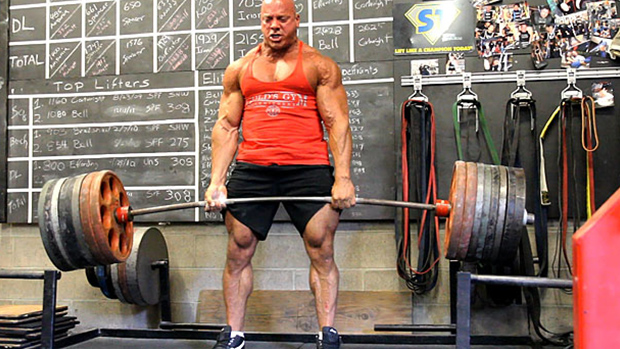At first glance, it might seem that the title of this article is
a double entendre (you know, like "Kid Rock Rules!"). I
assure you, it's not. My linguistic reference of choice is not
a music-challenged snowboarder but the Oxford English
Dictionary, or for all you acronym lovers: OED.
The OED defines "rule" in many contexts. The definition it gives
that's specific to this article is: "A regulation or principle
governing conduct or procedure within a particular sphere." The
sphere in question, of course, is fitness.
The longer I'm in this field, the more I learn. Now,
that's not a profound revelation to anyone since that should
be the case with any profession. But I think the fitness industry
might be even more mercurial than, say, trading stocks. Unlike the
"buy low, sell high" philosophy that drives the stock exchange, the
information and principles in the fitness industry are compounding
at an alarming rate. As such, my own training principles are going
through a metamorphosis at an alarming rate, too.
So that's why I'm starting this series. Whenever I
feel like I've accumulated enough new principles, tips, or
tricks to fill an article, I'll release another derivation
of Waterbury Rules.
This installment is going to cover people, program design, and
titles. Here goes!
People
1. Give Credit
I can say with utmost certainty that no article, program, or
principle of mine was devised entirely by me. I figured that was a
given, but I don't think I've given enough credit where
credit is due.
Testosterone has published articles from scads of professionals
over the years, and I'll tell you that every single person
who's had more than three articles published on this site has
influenced my training philosophy in a positive way. If you're
one of them, thanks!
2. Build a Constructive Criticism Team
Some of the most valuable people around me are more than willing
to give me constructive criticism, and I like that. One of the best
pieces of advice I was ever given was from one of my most
successful clients. He said to me, "Chad, don't surround
yourself with 'yes men' or you'll never reach your
ultimate potential." I took that tip to heart early in my career
and I can tell you that it's been invaluable to my success.
Now, don't misinterpret this advice as saying that you
should surround yourself with people who insult or belittle you:
that's merely insecurity oozing from a negative person.
It's important that the constructive criticism comes from
someone who's equally or more successful in the same
field that you're in.
For example, I don't care how successful a dentist or
taxidermist is, his opinions on my training principles mean nothing
to me. The same is true with a 20-year-old Bally's personal
trainer who questions what I do with my
clients.
Sometimes when I mistakenly respond to one of these insecure
dimwits, I'll get an email titled, "Dear Fuckhead... "
That's a term of endearment usually used by someone who's
part of my constructive criticism team: Alwyn
Cosgrove.
3. Understand Internet Forumites
The sooner you understand that no one's mind has ever been
changed in a forum battle, the better. Focus your energy on those
who're open-minded and receptive to a multitude of ideas.
Whether or not they end up following your philosophy isn't the
point.
Program Design
4. Follow Professional Programs if You're Ever Unsure of
Your Abilities
The latest trend in the fitness industry is to say that programs
suck. You should learn to train yourself, they say. I think
that's one of the most dangerous pieces of fitness advice
I've ever heard.
Here's an analogy to make my point: Let's say "Bobby"
is the heir to a substantial inheritance. He's approaching his
18th birthday, so he knows about as much as every other
17-year-old. Sure, he thinks he's figured life out, but we all
know he has much to learn. Now, imagine at his 18th birthday he's given the inheritance of three million
dollars.
So, two scenarios arise. The first one is that Bobby is left to
his own devices with three million dollars. I don't know about
you, but if I got three million dollars on my 18th birthday, within a few years that pile of cash would've been
replaced by five, 600 horsepower muscle cars, weekly trips to
Vegas, and enough hookers on call to scare Charlie Sheen.
The second scenario is that he hires a financial advisor to lead
him through investing and budgeting so he can maximize his three
million dollars.
Think of your body and that three million dollars as being the
same entity. The difference being that you can always make more
money, but you can't get another body.
Don't get me wrong, I understand exactly what the "programs
suck" gang is saying. There's simply no way a fitness writer
like me could ever intuitively know what a person exactly needs to
emphasize or avoid in his workouts. And even if I could design that
program, it would only be relevant for that one person. Nothing
works for everyone, and the holy grail of training is when you
discover what works for you, and what doesn't. Therefore, I
think the people who tell you to train yourself have good
intentions.
Nevertheless, it's still dangerous advice. A good coach
understands the key elements of volume, progressions, motor
patterns, and structural balance, just to name a few. So if
you're new to training, or if you're unsure of your own
training ability, by all means, follow a training program
that's designed by a reputable coach. After following those
programs you'll have a much better understanding of what works
for you and what doesn't. From there, you can slowly merge
into training yourself.
My advice is to spend at least one year of continuous training
with programs designed by professionals. After that, spend one
workout each week doing what you feel you need most. Do that for
three months and build from there, but be sure to check in with a
professional coach who can assess your joint integrity and
structural balance. If your personally-designed workouts are
throwing you out of whack, you need to find out as soon as
possible.
And yeah, I know what you're thinking. Just because a
program is designed by a professional doesn't mean you
can't potentially develop imbalances or joint problems. But
given the choice between a novice person figuring things out for
himself verses following a professional program, I think you'd
be wise to choose the latter.
Finally, I've never met anyone who trained himself from day
one who didn't permanently fuck up at least
one of his joints. Keep that in mind the next time you hear that
all programs suck.
5. Train Your Wrist Extensors, External Rotators, and Serratus
Muscles
Speaking of people I've never met... I've never met
anyone whose wrist extensors, external rotators, and serratus
muscles were strong enough for optimal performance and structural
integrity. Put simply, I don't care if you're currently
doing exercises for the three aforementioned muscle groups,
you're not doing enough.
Don't fall into the trap that these muscles must be trained
with high reps, either. They'll get bigger and stronger if you
train them with 80% of your 1RM with 6 rep sets, just like your
other muscle groups will. With that said, I typically don't
prescribe less than 6 reps per set for these muscle
groups.
So if you're not directly training the wrist extensors,
external rotators, and serratus muscles, I want you to start
– now. Perform the following exercises first in three of your
workouts every week, with at least 48 hours of rest between each.
Once you've trained them at the beginning of your workouts for
two months straight, you can put them in any part of your workout.
I don't care what type of training system you're on.
It doesn't matter; the following recommendations will work.
Here's a plan to get you started:
DB (dumbbell) external rotation, push-up plus, and wrist
extension
Monday: 4x6
Wednesday: 3x9
Friday: 3x12
(Note: Use the heaviest load you can handle for all
sets.)
DB external rotation
 |
 |
Push-up plus
 |
 |
Description: The key with the push-up plus is to push your
shoulder blades as far forward as possible in the "up" position.
This exercise can be performed on a Swiss ball or on the floor.
Wrist extension
 |
 |
There are many variations of the wrist extension exercise
that'll work. I'm just showing the above version because
it's often overlooked. (It's actually better if you split
the dumbbell handle between your middle and ring fingers.) But you
could simply rest your forearms on a flat bench with a palms-down
hand position. Hold an EZ bar or a dumbbell in each hand, and pull
your knuckles up as high as possible. Let your hand flex down into
a full stretch, regardless of the version you choose.
If you have any supraspinatus problems, avoid external rotation
movements that force you to hold your upper arms in the air. The
standing, arms elevated version is a good exercise, though. So if
you don't have supraspinatus problems, use it. What I'm
talking about is depicted below:
 |
 |
If you do have supraspinatus problems, perform the version where
your elbow is resting on your knee (shown in the above plan). If
the "rested elbows" version causes pain in your supraspinatus, do
the version with your elbow next to your side. Externally rotate a
cable with a pulley that's set at the height of your
navel.
For a good study on the push-up plus and how it relates to
serratus activation, check this out: Ludewig, et al. Am J Sports
Med. 32(2): 484-93, 2004.
6. Train Your Hip Abductors and Adductors
The number one and number two weaknesses that I typically see in
the lower body are with the hip abductors and hip adductors,
respectively. Weak glutes is number three but I'll save that
for another installment. Plus, I don't want to overwhelm you
with too many new exercises at this point.
So I want you to start training your hip abductors and adductors
at the beginning of three of your workouts each week (yes, you can
do them after the external rotation, serratus, and wrist extensor
exercises, or before those exercises). Use the same parameters that
I prescribed for the upper body exercises. Here's how it
looks:
Hip abduction and hip adduction
Monday: 4x6
Wednesday: 3x9
Friday: 3x12
(Note: Use the heaviest load you can handle for all
sets.)
I don't care what tool you use to train your abductors and
adductors: plate, cable, machine – they'll all work. In
fact, it's ideal if you rotate between the plate, cable, and
machine versions. Here's how the plate version looks for hip
abduction:
 |
 |
Here's how the band, or cable, version looks for hip
adduction:
 |
 |
Keep in mind, the above depictions are only intended to show you
the basic hip action with regard to abduction or adduction. The
pictures aren't meant to show you the versions that I
necessarily think are best.
So the next time you're in the gym, kick the fat lady off
the hip abductor and hip adduction machines. If you start training
those muscle groups with the parameters I prescribe, your lower
body strength and performance will skyrocket!
7. Do the Over-Under Everyday
If you can't touch your fingers together with the
over-under test (shown below), I want you to immediately stop all
upper body training except for the exercises in rule #5. Yes,
that's right, all upper body training.
You probably don't want to hear that, right? At the very
least, stop all horizontal pressing and vertical pulling until you
can pass the over-under test. Trust me, it's important to be
able to touch your fingers together. You'll decrease shoulder
pain and enhance longevity in your shoulder joints if you try to
touch your fingers together after every workout, and throughout the
day.
For each side, this is what you should be able to do (the test,
not the girl):
 |
How often should you perform the over-under drill? As often as
possible, if you can't touch your fingers together. How long
should you hold the stretch? Between 10 and 30 seconds. It's
really that simple.
Once you can touch your fingers together, be sure to recheck
your over-under mobility at least twice each week so you don't
lose what you've gained.
Titles
8. Define Total Body Training (TBT) and Body Part Splits (BPS)
Correctly
No topic in the history of fitness has spawned more hatred,
penis-waving, and downright ignorance than the TBT verses body part
split debate. I'm happy to say that I'm not here to
partake in such nonsense, but I do want to give the flame-throwers
some more precise tools to work with.
What in the hell does TBT mean anyway? What does a body part
split mean? Those are two questions that many people haven't
spent nearly enough time thinking about. So I'm going to
define TBT and body part splits right here and now. If you
don't completely agree with my definitions I encourage you to
still accept them since, at the very least, you'll know what
you're arguing for or against. Here are the
definitions:
Total Body Training (TBT) – A training system where
each workout is comprised of at least one, multi-joint upper body
pressing and pulling movement along with one, multi-joint lower
body movement.
Body Part Split (BPS) – A training system that
emphasizes key muscle groups in each workout that doesn't
include one, multi-joint upper body pressing and pulling movement
along with one, multi-joint lower body movement in each
workout.
So, for the last time, TBT isn't an acronym that's
synonymous with a system that's only made
up of multi-joint movements, but it must include the three
aforementioned movements. BPS isn't an acronym that's
synonymous with a system that's only made up of single-joint
movements, but it can't include the three aforementioned
movements in any single workout.
Conclusion
That's it, eight rules you should immediately apply to your
life, training, and discussions. I hope you'll incorporate all
eight. If you do, I guarantee it'll improve your life and
training.




